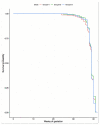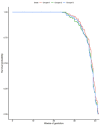Impact of COVID-19-Related Lockdown on Delivery and Perinatal Outcomes: A Retrospective Cohort Study
- PMID: 35160207
- PMCID: PMC8837050
- DOI: 10.3390/jcm11030756
Impact of COVID-19-Related Lockdown on Delivery and Perinatal Outcomes: A Retrospective Cohort Study
Abstract
Objective: The magnitude and direction of effects on pregnancy outcomes of the lockdown imposed during COVID-19 have been uncertain and debated. Therefore, we aimed to quantify delivery and perinatal outcomes during the first nationwide lockdown due to the COVID-19 pandemic compared with the same durations of time for the pre- and post-lockdown periods.
Study design: This was a retrospective cohort study of six university hospital maternity units distributed across France, each of which serves as the obstetric care referral unit within its respective perinatal network. Maternal and perinatal outcomes were compared between the lockdown period and same-duration (i.e., 55-day) periods before and after the 2020 lockdown (pre-lockdown: 22 January-16 March; lockdown: 17 March-10 May; post-lockdown: 11 May-4 July). We compared the overall rates of Caesarean delivery (CD), pre-labor CD, labor induction, operative vaginal delivery, severe postpartum hemorrhage (≥1 L), severe perineal tear, maternal transfusion, and neonatal mortality and morbidity (1- and 5-min Apgar scores < 7), hypoxia and anoxia (umbilical arterial pH < 7.20 or <7.10, respectively), and admission to a neonatal intensive care unit before discharge. Adjusted odds ratios were estimated using logistic regression, controlling for region of birth, maternal age category, multiparity, multiple pregnancies, diabetes, and hypertensive disorders.
Results: The study sample consisted of 11,929 women who delivered consecutively at one of the six maternity units studied (4093 pre-lockdown, 3829 during lockdown, and 4007 post-lockdown) and their 12,179 neonates (4169 pre-lockdown, 3905 during lockdown, and 4105 post-lockdown). The maternal and obstetric characteristics of the women delivering during the lockdown period were alike those delivering pre- and post-lockdown on maternal age, parity, body mass index, rate of complication by hypertensive disorders or insulin-treated diabetes, and gestational age at delivery. Overall CD rates were similar during the three periods (23.6%, 24.8%, and 24.3% pre-lockdown, lockdown, and post-lockdown, respectively) and no outcome differed significantly during lockdown compared to pre- and post-lockdown. These findings were consistent across maternity units.
Conclusion: The maternal and perinatal outcomes are reassuring regarding the performance of the health-care system during the COVID-19 lockdown studied. Such information is crucial, because additional COVID-19-related lockdowns might still be needed. They are also instructive regarding potential future pandemics.
Keywords: lockdown; pandemic COVID-19; perinatal and obstetrical issues; pregnancy.
Conflict of interest statement
The authors declare no conflict of interest.
Figures



References
-
- WHO Director-General’s Opening Remarks at the Media Briefing on COVID-19—11 March 2020. [(accessed on 12 March 2020)]. Available online: https://www.who.int/dg/speeches/detail/who-director-general-s-openingrem....
-
- DÉCRET DU n° 2020-260 DU 16 MARS 2020 PORTANT RÉGLEMENTATION DES DÉPLACEMENTS DANS LE CADRE DE LA LUTTE CONTRE LA PROPAGATION DU VIRUS COVID-19. [(accessed on 8 May 2020)]. Available online: https://www.legifrance.gouv.fr/jorf/id/JORFTEXT000041728476?r=2JghG4TgkV.
-
- IllicoMed CORONAVIRUS (Statistiques Février 2020): LES INQUIÉTUDES ET LES RÉACTIONS DES FRANÇAIS—Illicomed & IFOP. [(accessed on 8 May 2020)]. Available online: https://www.illicomed.com/coronavirus-statistiques/
-
- Santé Publique France. COVID-19: POINTS ÉPIDÉMIOLOGIQUES HEBDOMADAIRES NATONIAUX ET RÉGIONAUX. [(accessed on 20 July 2020)]. Available online: https://www.santepubliquefrance.fr/dossiers/coronavirus-covid-19/coronav....
LinkOut - more resources
Full Text Sources

